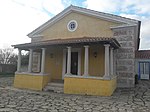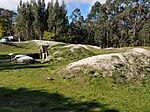Basilica of Our Lady and Saint Anthony of Mafra

The Basilica of Our Lady and Saint Anthony of Mafra is a Roman Catholic shrine and basilica located within the Palace of Mafra, Portugal. It is designated as a Basilica by the privilege of immemorial status. The shrine is dedicated to the Blessed Virgin Mary and Saint Anthony of Padua which once fostered religious devotion among the Portuguese nobility. The Basilica enshrines several Baroque artworks and Christian relics from various European kings collected in Portugal over the centuries. It also serves as the main headquarters the Royal and Venerable Confraternity of the Most Blessed Sacrament of Mafra.The basilica was designated as a National Monument in 1910. Since 7 July 2019, the basilica as part of other surroundings was declared a UNESCO World Heritage Site.Pope Francis officially granted a decree of Pontifical coronation towards the dolorous image of the Blessed Virgin Mary under the venerated title “Our Lady of Solitude” on 10 November 2020. The rite of coronation was executed by the former Archivist of the Holy Roman Church, Cardinal José Tolentino de Mendonça on 17 September 2023.
Excerpt from the Wikipedia article Basilica of Our Lady and Saint Anthony of Mafra (License: CC BY-SA 3.0, Authors, Images).Basilica of Our Lady and Saint Anthony of Mafra
Alameda da Escola Prática de Infantaria,
Geographical coordinates (GPS) Address Nearby Places Show on map
Geographical coordinates (GPS)
| Latitude | Longitude |
|---|---|
| N 38.9369 ° | E -9.3264 ° |
Address
Basílica do Convento de Mafra
Alameda da Escola Prática de Infantaria
2640-459 (Mafra)
Portugal
Open on Google Maps









